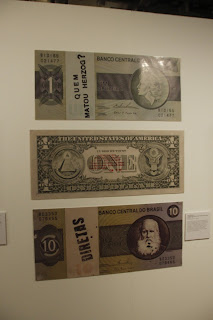We went on a course visit to the People's History Museum in Manchester to see a very relevant exhibition titled 'Show Me The Money'.This
exhibition charts how the financial world has been imagined in art,
illustration, photography and other visual media.
This
exhibition asks: what does ‘the market’ look like? What does money really
stand for? How can the abstractions of high finance be made visible? Who
is finance for? The exhibition charts how the financial world has been
imagined in art, illustration, photography and other visual media over the last
three centuries in Britain and the United States. The project asks how
artists have grappled with the increasingly intangible and self-referential
nature of money and finance, from the South Sea Bubble of the 18th century
to the global financial crisis of 2008. The exhibition includes an array
of media: paintings, prints, photographs, videos, artefacts, and instruments of
financial exchange both ‘real’ and imagined. Indeed, the exhibition also
charts the development of a variety of financial visualisations, including
stock tickers and charts, newspaper illustrations, bank adverts, and electronic
trading systems.
Show Me The Money demonstrates that the visual culture of finance has not merely
reflected prevailing attitudes to money and banking, but has been crucial
in forging – and at times critiquing – the very idea of ‘the market’.
I found the visit to the exhibition very helpful, as it allowed me to realise that currency has a massive presence in visual culture. I certainly take the design of money for granted, and this show allowed me to realise the complexity and co-ordination that goes into the aesthetic of something that I was supposedly so familiar with. The show also allowed me to realise that I could use this brief to make an statement, make an impact and be controversial in my approach to the design, as the majority of the works in the show were just that. It opened my eyes to the possibilities in terms of concepts and aesthetics. It was a great starting point in terms of primary research for this brief.















No comments:
Post a Comment